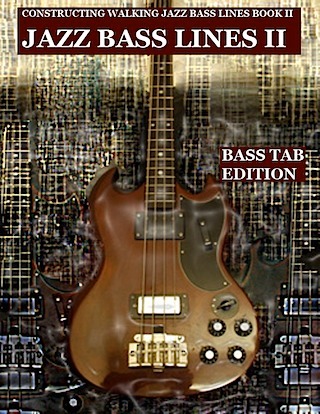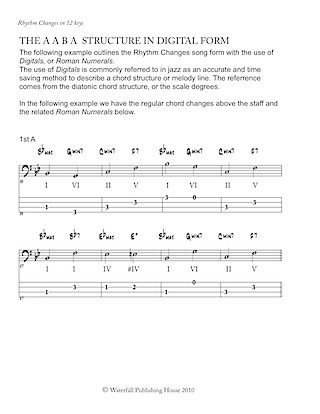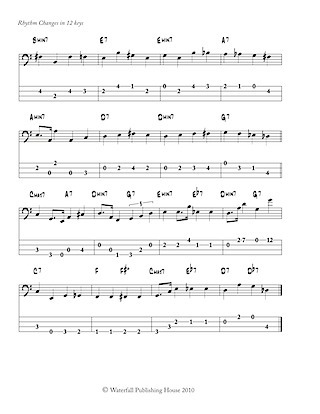Bass guitar lesson jazz bass tab - walking bass line Rhythm changes in A - YouTube
Book II 32% off was $24.95 - $16.95
AMAZON USA
AMAZON UK
AMAZON JAPAN
AMAZON GERMANY
AMAZON FRANCE
AMAZON CANADA











Rhythm Changes in 12 Keys Book II in the " Constructing
Walking Jazz Bass Lines " Bass Tab series for the Electric Jazz Bassist.
Rhythm Changes in 12 Keys compliments Book I " The Blues in
12 Keys " by following on with an in depth study of " must know "
Jazz chord progressions for the aspiring Jazz Bassist.
Rhythm Changes in 12 Keys is a complete guide demonstrating the
devices used to construct walking jazz bass lines in the jazz tradition.
Part 1 of the book outlines and demonstrates the various
techniques used by professional Jazz Bassists to provide forward
motion and a strong harmonic and rhythmic foundation into bass
lines.
All exercises are designed to give the Electric Bassist strong
jazz bass lines in the bottom register of the instrument.
An additional bonus for the Electric Bassist, Part 1 provides a
complete study of Bb Rhythm Changes whilst in the first position.
This is an excellent technical study for building strength, improving
intonation and being able to walk strong bass lines at increased
tempos in the bottom register of the instrument.
Part 2 expands on the lessons and techniques used in Part 1
providing the aspiring Jazz Bassist with the previous devices used in
professional level bass lines in all 12 keys. Providing over 70 choruses
of Rhythm Changes in all 12 keys using the whole register of the
instrument. In total there are over 100 choruses of Rhythm Changes
included in Part I and Part II of this book.
There are many advanced principles applied in the following bass
lines whilst never losing sight of the functioning principle of the bass
in the jazz idiom. To provide a strong foundation of rhythm and
harmony for the music being played & providing support for the
melody and or soloist.
TABLE OF CONTENTS
Part 1 Rhythm Changes ..............................................................
The AABA Form .......................................................................
The AABA Structure in Digital Form ........................................
Diatonic 7ths in the key of Bb major .................................. .......
The "2" feel ................................................................................
Embellishing the "2" feel ...........................................................
The Dominant 7th chord ...........................................................
Chromatic approach from below ...............................................
Chromatic approach from above ................................................
Chromaticism and the walk up
and the walk down .....................................................................
Repeated notes and chromaticism ..............................................
Harmonic anticipation and
playing across the bar line ..........................................................
Voice leading and 7th chords .....................................................
Pedal points ................................................................................
Tri-Tone substitution .................................................................
Expanding on the use of Tri-Tone substitution ...........................
The Turnaround ...........................................................................
Turnarounds and the AABA Form .............................................
Rhythm Changes the "A" section progressions ...........................
Rhythm Changes the Bridge ......................................................
Secondary Dominant Chords ......................................................
Rhythm Changes the Bridge chord substitutions ........................
Part 2 Rhythm Changes in 12 Keys .......................................
Rhythm Changes in Bb ...........................................................
Rhythm Changes in B .............................................................
Rhythm Changes in C .............................................................
Rhythm Changes in Db ...........................................................
Rhythm Changes in D .............................................................
Rhythm Changes in Eb ...........................................................
Rhythm Changes in E .............................................................
Rhythm Changes in F ..............................................................
Rhythm Changes in Gb ...........................................................
Rhythm Changes in G .............................................................
Rhtyhm Changes in Ab ...........................................................
Rhythm Changes in A .............................................................
In Conclusion ..........................................................................
RHYTHM CHANGES
Rhythm Changes like the " Blues " is an essential part of the Jazz
musicians vocabulary.
The following chapters provide various insights into how the Rhythm
Changes song form may be approached.
It is essential for the aspiring bassist to learn the following material
in all 12 keys as layed out in the following chapters. It is then
advised that the student take the various lines and devices and build
their own bass lines by substituting various A section or B section
bass lines from the examples within.
Write the lines out on manuscript.
This will enable the student to compose and hear their own bass
melodies and to accelerate the process of becoming a Jazz Bassist in
their own right.
It is essential for the Jazz Bassist to have a strong understanding
of the harmony of the music being played, a solid rhythmic
foundation but most importantly to have their own sound and
identity.
Enjoy the book.
The Bass Tablature Series of " Constructing Walking Jazz Bass Lines "
is designed to make available the same information to the bassist not experienced with reading music.
All examples , lesson topics and bass lines are the same as the bass clef series for the Double Bassist.
For the student wanting to learn to read music all examples and bass lines are shown in tablature with the standard bass clef directly above.
This enables the bassist to apply what they already know to the task of learning to read music. This is excellent study material .
The book covers all aspects of learning how to construct walking bass lines with
step by step instruction and various lesson topics . All examples are outlined by the author with sample bass lines which build from chapter to chapter.

